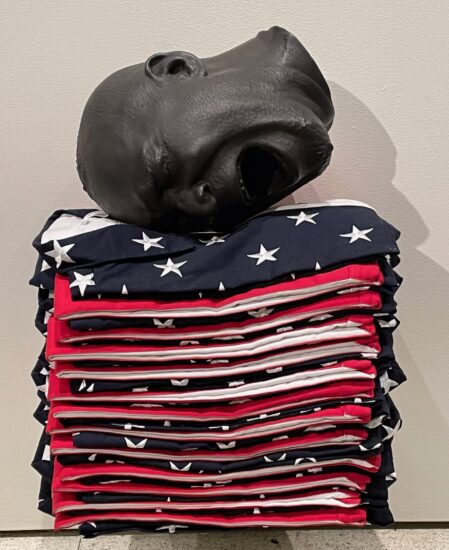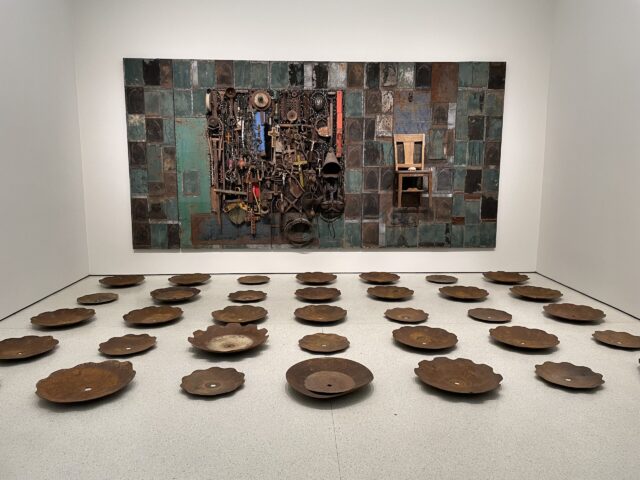
Nick Cave, Untitled, mixed media including a bronze head and thirteen American flag shirts, 2018 (Ann and Mel Schaffer Family Collection / photo by twi-ny/mdr)
NICK CAVE: FOROTHERMORE
Solomon R. Guggenheim Museum
1071 Fifth Ave. at 89th St.
Through April 10, $18-$25
212-423-3587
www.guggenheim.org
forothermore slideshow
Nick Cave’s oeuvre consists of tantalizing, colorful objects and installations that are immediately eye-catching, inspiring childlike wonder. It was no surprise that when I was walking through “Nick Cave: Forothermore” at the Guggenheim, several kids were running around like they were in a playground. I actually had to stop two children from grabbing the small balls and dominoes carefully arranged in Forbidden and Desire (1998); while one boy’s father was grateful, the other’s mother gave me a stern look. I think she wanted to chastise me for saying anything to her child, but she realized that it was probably a good idea that her boy not touch the valuable artwork. When I mentioned to a security guard what I had experienced, they acknowledged that it was a continuing problem.
But the sixty-four-year-old Cave’s works are a lot more than intriguing, pretty pieces; the Missouri-born, Chicago-based multimedia artist explores loss, mourning, racial injustice, the importance of community, and joy through sculpture, painting, video, installation, and performance, incorporating found objects as he examines the Black experience in America.
On view through April 10, the show is divided into three sections: “What It Was,” “What It Is,” and “What It Shall Be,” examining the past, present, and future of Cave’s practice as well as the state of our society. Penny Catcher (2009) welcomes visitors to Tower 2, a depiction of a male figure in a black suit and black-and-white spats hanging on a wall, his mouth open to accept coins, a repurposed relic from a flea market. I Wouldn’t Bet Against It (2007) is centered by a miniature person praying in front of several dozen dice, surrounded by a halo that creates a dizzying optical illusion. Wall Relief (2013) comprises four large panels festooned in a thick morass of ceramic birds, afghans, strung beads, crystals, and antique gramophone speakers, with metal flowers emerging on all sides. Nearby is TM13 (2015), one of Cave’s signature Soundsuits, bigger-than-life mannequins that the queer Black artist began creating after the Rodney King beating during the 1991 LA riots; this one is based on Trayvon Martin, trapped in a net, one sneakered foot sticking out at the bottom, accompanied by vintage blow molds, including Santa, a bear dressed for Halloween, and St. Joseph from the Nativity scene.
In Tower 4, Sea Sick (2014) is a collage of eleven oil paintings of old-time sailing ships at sea, with a sculpture of a gold-colored plastic ship hovering over the head of a screaming Black man, hands lifted to his head, his red lips and white teeth defying stereotypes.
“I started to think about how racism’s transferred over into consumerism and product,” Cave (Until, Mass MoCA, 2017; The Let Go, Park Ave. Armory, 2018) explains on the accompanying audioguide, in a way that serves as a kind of artist statement for the entire exhibition. “I had this set of gold praying hands, but the way in which they’re positioned with Sea Sick is that they’re covering up his ears just to numb out the sound, this sort of anguish, this sort of rage. And then above is this gold bling-bling ship that pulls it right into this contemporary moment in which we exist right now. It’s surrounded by these ship paintings that I have found in thrift stores, reclaiming and repositioning how we engage in experience and talk about this voyage of sorts to the free world. And so all of that is in question because these objects are reconfigured in and renegotiating the role in which they present themselves today. So to me it’s not that it’s yesterday; it’s very much today. As I start to look at the work, I start to think about the community’s outreach, that I’m only a vessel. I feel that I’ve been the one chosen to deliver these deeds. I have a job to do; I am the voice for many people, and it’s really being able to celebrate our differences. . . . That I can I can stand here, you can stand here, and we can be in this moment collectively is that moment I’m wanting to talk about.”

Nick Cave, Time and Again, mixed media including vintage metal, found objects and wood, 2000 (courtesy the artist / photo by twi-ny/mdr)
Also in Tower 4 is the fourteen-minute video Bunny Boy (2012), in which Cave, who presented the performance “Heard•NY” in Grand Central in 2013, dances suggestively in one of his Soundsuits; Platform, which contains black gramophone speakers, a crow, and chains of arms grasping hands, either coming down from or going up to heaven; and Rescue (2013), in which several dogs are seated on couches and chairs. Chairs are a recurring theme, also seen in an untitled 2018 piece in which an empty pink high chair is in front of a table of praying heads and hands, evoking a missing child, and Time and Again (2000), an installation with a chair with a tiny white pig on it attached to a canvas laden with Cave’s late grandfather’s wooden and metal farming tools and crosses, rows of rusted agricultural dishes lined up on the floor.
The centerpiece of the exhibit are the Soundsuits in Tower 5, with more than a dozen on a white platform as if frozen in time during a fashion show. The mannequins are covered in a multitude of colors and objects, from vintage textile and sequined appliqués to toy globes, flowers, hip pants, spinning tops, little pales and shovels, sock monkeys, bunnies, and boots. Perched on the walls, and also used as faces for a few Soundsuits, are Cave’s circular kaleidoscopic wire mesh and beaded Tondos, which he says “is me looking at these brain scans of inner-city youth that live in extreme, violent zones, and the trauma that comes from that, and pairing that with extreme weather patterns — colliding these two forces together.”
It’s a visual feast for children of all ages — and once again needs security to make sure kids don’t jump onto the platform and touch the pieces. There were too many of them running around for even me to stop them, especially since I was having just as much fun. But as fun as they are, as with TM13, they make critical points about where we’ve been, where we are, and where we are going as a society. These feasts of visual exuberance bear titles such as 8:46 and 9:29, grounding them in time and space: The numerals refer to the murder of George Floyd by Minneapolis police.